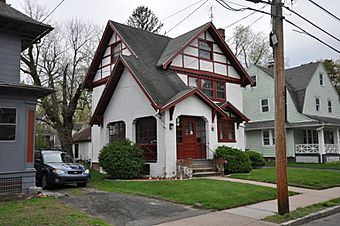Dr. Frank T. Simpson House facts for kids
|
Dr. Frank T. Simpson House
|
|
|
U.S. Historic district
Contributing property |
|
 |
|
| Location | 27 Keney Terr., Hartford, Connecticut |
|---|---|
| Area | less than one acre |
| Built | 1913 |
| Built by | Wright, W. Foster |
| Architectural style | Tudor Revival |
| Part of | Upper Albany Historic District (ID86003383) |
| NRHP reference No. | 93001246 |
Quick facts for kids Significant dates |
|
| Added to NRHP | December 2, 1993 |
| Designated CP | September 29, 1986 |
The Dr. Frank T. Simpson House is a special old house in Hartford, Connecticut. It was built in 1913 and looks like a classic English home, a style called Tudor Revival. This house was once the home of Dr. Frank T. Simpson, a very important leader in the fight for equal rights in Connecticut during the middle of the 20th century.
The house was added to the National Register of Historic Places in 1993. This means it is recognized as an important historical place. It is also part of a larger area called the Upper Albany Historic District.
What Does the House Look Like?
The Dr. Frank T. Simpson House is in a neighborhood in north Hartford. It is a two-and-a-half story building made of wood. The outside is covered in a material called stucco. The roof has a special shape with parts that stick out, called gables.
The front of the house has a main entrance that is set back in an archway. You can see decorative parts on the gables. Some parts of the house also have a half-timbered look, which is typical for the Tudor Revival style. This style makes the house look like homes from old England.
Who Was Dr. Frank T. Simpson?
The house was built in 1913 by a builder named W. Foster Wright. Dr. Frank T. Simpson and his wife, Marie A. Simpson, bought the house in 1952.
Dr. Simpson was born in Alabama and moved to Hartford in 1929. He became a very important person in Connecticut. In 1944, he became the first paid worker for the state's civil rights commission. This group was one of the first of its kind in the United States.
Dr. Simpson helped lead this commission. They worked to show where people were not being treated fairly. This included problems with getting good education and jobs. Thanks to his work, many barriers were removed, helping people get equal chances.



